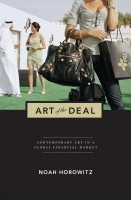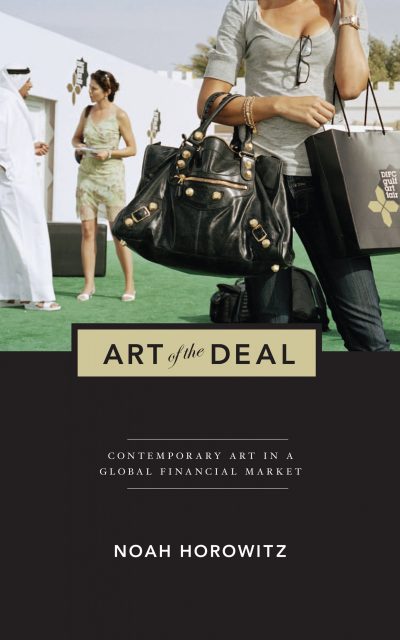 Author: Noah Horowitz
Author: Noah Horowitz
Publisher: Princeton University Press
Book Review by: Paiso Jamakar
If you listen to television news these days about the prices some paintings are being bought for at auctions – in the millions of dollars – you wonder most of the time how the sellers come up with the such high starting prices to begin with. And it also makes you wonder how art collectors who bid at these auctions arrive at a value for any painting they want to buy, especially when the bid price is in the hundreds of thousands, or even millions of dollars.
Like any business you want to learn about, you begin by going to events where people in the same business congregate. In this case, you watch the auctions, and ask questions of buyers. Perhaps you can offer them some information of value to them in return for answering your questions.
You can also go on the Internet (before or after going to the events) to search for the information you are looking for. In the world of art for example, you can look at the prices sold in the last 12 months (for example) of similar paintings of a particular artist. That’s a good start, I think.
Trying to make sense of the amounts of money some people spend (invest?) for art work is oftentimes, I think, an exercise in madness. As Leo Castelli, an art dealer, said in 1966 (who is quoted at the beginning of this book:
“Why should anyone want to buy a Cezanne for $800,000? What’s a little Cezanne house in the middle of a landscape? Why should it have value? Because it’s a myth. We make myths about politics, we make myths about everything. I have to deal with myths from 10 am to 6 pm every day. And it becomes harder and harder. We live in an age of such rapid obsolescence….My responsibility is the myth-making of the myth material – which handled properly and imaginatively is the job of the dealer – and I have to go at it completely. One just can’t prudently build up a myth.”
Noah Horowitz begins this book by writing on his Preface that the art market experienced one of the biggest booms in history at the beginning of the new millennium. Contemporary art in particular was sort of the star of the art market, or as Horowitz describes it, “the most lucrative sales category,” as though a department store merchandise buyer was speaking.
On September 15, 2008, the artist Damien Hirst began a two-day event (bypassing art dealers) at Sotheby’s in London, named Beautiful Inside My Head Forever – one of the biggest auctions in history both in terms of the number of works that were offered and the staggering amount he had estimated it would garner.
More than 200 works were made available for sale, valued at a presale estimate of between $122 million and $176 million. Astonishingly, a total $201 million was realized from sales of the art works, way above expectations! It set a record for a single-artist auction. The highest-grossing lots were The Golden Calf and The Kingdom, which fetched $19 million and $17.6 million, respectively. The well-planned and highly pre-publicized show brought in more than 21,000 people, according to Wikipedia.
Horowitz writes that on the very day this huge auction took place, Lehman Brothers declared bankruptcy, Merrill Lynch announced it would be sold to rival Bank of America, and the giant insurance company American International Group announced it was failing, which was followed the next day by an $85 billion bailout by the U.S. Federal Reserve.
These and other events were part of the 2008 financial crisis which saw the housing bubble in the United States burst, after massive numbers of people (who received financing for real estate purchases even if they had sub-par credit histories) were unable to keep up with payments of their mortgages.
Horowitz has divided the material he offers in this book into just three chapters, preceded by an Introduction and ending with a Conclusion. But in addition to that, there is some interesting information in the appendices, especially in Appendix A. Here’s how this book is organized:
- Introduction
- Video Art
- Experimental Art
- Art Investment Funds
- Conclusion
- Postscript to the Paperback Edition
- Appendices:
- A, Record Prices for Video Art at Auction, December 2009
- B. The Film and Video Collections of Tate and the Whitney Museum of American Art
- C. Art Investment Fund Universe’
- Notes
- Selected Bibliography
- Index
This book also contains 41 images of art works, three graphs, and five tables with data.
Why was this book written?
In the words of the author, “Art of the Deal undertakes a critical account of the art market and how its values (critical museological, financial) are generated. Specifically, the book will navigate through some lesser-known examples that have not been considered together in literature, spanning the rise of art investing and how practices such as video art and what I shall call “experimental” art are collected.”
“This text is a testament to the diffuse developments that have lacked cohesion and accountability in the art discourse. By uniting them under one umbrella, I hope to demonstrate why they must be considered as one and this is so urgent now.”
Noah Horowitz holds a PhD in art history from the Courtauld Institute of Art in London. He currently lives in New York, where he is a member of the faculty of the Sotheby’s Institute of Art and executive director of the Armory Show.







